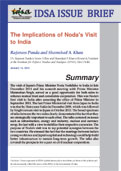The Implications of Noda’s Visit to India

The visit of Japan’s Prime Minister Noda Yoshihiko to India in late December 2011 and his summit meeting with Prime Minister Manmohan Singh, served as a good opportunity for both sides to enhance mutual trust and consolidate cooperation. This was Noda’s first visit to India after assuming the office of Prime Minister in September 2011. The last Prime Ministerial visit from Japan to India was that by Hatoyama Yukio in December 2009, which was followed by Singh’s return visit to Japan in October 2010. The broad spectrum of talks between the two sides clearly demonstrated the fact that they are strategically important to each other. The talks centered on issues such as infrastructure, energy and industry, nuclear and currency swap, the last with a view to stabilize their respective currencies. The purpose of Noda’s visit was to tap potential synergies between the two countries. He stressed the fact that the marriage between India’s young workforce and Japan’s capital and technology could help build better infrastructure to sustain long-term growth. The talks also covered the prospects for a pact on civil nuclear cooperation.







